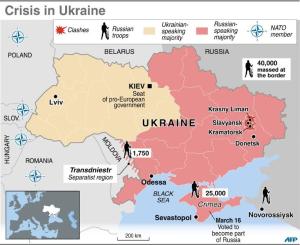KRAMATORSK, Ukraine (AP) — In the first Ukrainian military action against a pro-Russian uprising in the east, government forces said they repelled an attack Tuesday by about 30 gunmen at a small airport.
The clash came hours after Ukraine's acting president, Oleksandr Turchynov, had announced an "anti-terrorist operation" against the armed, pro-Russian insurgents who had seized control of numerous buildings in at least nine cities in Ukraine's restive east.
The central government has so far been unable to rein in the insurgents, who it says are being stirred up by paid operatives from Russia. The insurgents are demanding broader autonomy and closer ties with Russia, and, complicating the political landscape, many local security forces have switched to their side.
The clashes Tuesday came at Kramatorsk airport, just south of the city of Slovyansk, which is 160 kilometers (100 miles) from the Russian border. The city has come under the increasing control of the gunmen who seized it last weekend.
The precise sequence of events in Kramatorsk was mired in confusion amid contradictory official claims.
Ukraine's security services anti-terrorist unit chief, Gen. Vasyl Krutov, speaking outside Kramatorsk airport, said his men managed to thwart an attack by fighters in green military uniforms without insignia who tried to storm the facility in the late afternoon.
An Associated Press reporter and camera crew at the airport heard rounds of gunfire at the time.
After the armed standoff, hundreds of local people surrounded the airport in response to rumors that government troops were planning to launch a military operation on the city of Kramatorsk itself. Some in the crowd attempted to enter the military facility, prompting Ukrainian troops to fire bursts of warning shots.
View gallery

An Ukrainian soldier aims his rifle at pro-Russia protesters gathered in front of a Ukrainian airbas …
There were conflicting reports of casualties. Yury Zhadobin, coordinator of a pro-Russian defense force, said two people were slightly injured and were taken to a hospital. Russian media, without sourcing, claimed anywhere from four to 11 casualties at the airport. Ukraine's government said there were no casualties and added that Ukrainian forces took an unspecified number of militiamen prisoner.
In an attempt to defuse the standoff, Gen. Krutov came out to speak to the crowd of people picketing the airport but was attacked by them.
While he spoke of repelling an attack, the new government in Kiev declared that its forces had recaptured the airport from militiamen.
"I just got a call from the Donetsk region: Ukrainian special forces have liberated the airport in the city of Kramatorsk from terrorists," Turchynov told parliament. "I'm convinced that there will not be any terrorists left soon in Donetsk and other regions and they will find themselves in the dock - this is where they belong."
The United States on Tuesday gave its tacit support to Ukrainian military action against pro-Russian militia. This is not the preferred option, White House spokesman Jay Carney said, but the Ukrainian government has to respond to what he said was an untenable situation.
What was clear is that the area bordering Russia is getting increasingly armed and unstable. Russia itself also has tens of thousands of troops stationed along the border, which Western officials say is adding to the instability.
Earlier Tuesday, an Associated Press reporter saw at least 14 armored personnel carriers with Ukrainian flags, helicopters and military trucks parked 40 kilometers (24 miles) north of the city. Other heavy military equipment appeared nearby, along with at least seven busloads of government troops in black military fatigues.
View gallery

Map of Ukraine (130x115 mm) (AFP Photo/S.Ramis/A.Bommenel, pld/jfs)
"We are awaiting the order to move on Slovyansk," said one soldier, who gave only his first name, Taras.
Two of the helicopters loaded with troops were later seen taking off and flying toward Slovyansk. Witnesses said helicopters delivered several dozen troops to the Kramatorsk military airfield.
The clash was viewed entirely differently by Ukraine and Russia.
Ukraine's ex-prime minister and presidential candidate Yulia Tymoshenko said Tuesday what Kiev was seeing in the country's east was, in effect, a war.
"We have to tell the Ukrainians the truth: The Russian Federation is waging a real war against Ukraine in the east, in the Donetsk and Luhansk regions in particular," she said.
She called on the West to "recognize Russia's aggression against eastern Ukraine as a war."
Ukrainian First Deputy Prime Minister Vitaly Yarema also accused Russia of sending its troops to Ukraine, saying Kiev has "evidence that those people occupying Slovyansk and Kramatorsk right now are servicemen of the Russian 45th Airborne Regiment."
Ukraine's security services also identified one of the leaders of the pro-Russian operation in Slovyansk as a Russian foreign intelligence agent named Igor Strelkov, who it said also coordinated Russian seizures of military facilities in Crimea.
Dmitry Peskov, a spokesman for Russian President Vladimir Putin, dismissed all those claims as absurd.
Late Tuesday, Russia's Foreign Ministry issued a statement condemning the Ukrainian military operation, saying it was "criminal to fight with your own people as they speak out for their legal rights." The ministry called on Russia's "international partners" to condemn the new Ukrainian government's actions.
Russia has strongly warned Kiev that if it uses military force it could prompt Moscow to walk out of Thursday's international conference on Ukraine in Geneva.
The events in Ukraine helped pushed global stock markets down as investors worried that the West might scale up sanctions against Russia. The DAX index in Germany, which has strong trade ties with Russia and imports a third of its gas from the country, fell 1.8 percent while Moscow's MICEX slumped 2.5 percent.
Ukraine's currency, which last week hit a record low against the dollar, was stabilized after the central bank hiked interest rates.
___
Leonard reported from Donetsk. Maria Danilova and Nataliya Vasilyeva in Kiev, Lynn Berry and Vladimir Isachenkov in Moscow, Julie Pace in Washington, D.C., and Christopher Bodeen in Beijing contributed to this report.